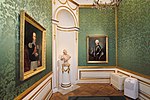Braid style

In German architecture, a style in the transition between Rococo and Classicism in the period around 1760 to 1790 is referred to as the plait style . It is sometimes also called Rocococlassicism and corresponds roughly to the Louis Seize style in France, the Josephine style in Austria and the Late Georgian in England. Despite some stylistic similarities, it is to be distinguished from the earlier classicist baroque .
The plait style is already strongly influenced by the new classical and ancient ideals, but still shows stylistic rudiments of the late Baroque and Rococo . In contrast to the Baroque style, which was shaped by the nobility, the Enlightenment bourgeoisie played a key role in the development of this style, which is characterized by its simplicity and based on ancient models.
The rather disrespectful-sounding name Zopfstil was coined by the mature classicists at the beginning of the 19th century. The word braid was synonymous with old-fashioned. The exact derivation of the term is not entirely clear. Possibly the term was coined by the often used plait-shaped leaf ornaments and flower garlands (see festoon ). Perhaps it also refers to the plait wig worn in the second half of the 18th century, which was already out of fashion before 1800. In the 19th and early 20th centuries, this epoch was sometimes called the plait time . One of Ferruccio Busoni's 4 Bagatelles, Op. 28, is called Aus der Zopfzeit .
One example is the Sorgefrei house , a mansion in Oberlößnitz / Radebeul that was built between 1785 and 1789 .
Trivia
The transition between baroque and classicist-enlightened heraldry between 1700 and 1800 is referred to in heraldic literature as "braid heraldry" based on the "plait style".
gallery
Braid-style bedroom at Esterházy Palace , Fertőd
Typical plait style ornament, Pöckstein Castle in Strasbourg (Carinthia)
Cabinet in Ludwigslust Palace
Ornaments in plait style at the Heiligenkreuzerhof in Vienna
Kynast , tower house with tower structure (plait style)
Web links
- Braid style. In: The large art dictionary by PW Hartmann , accessed on May 19, 2013.
Individual evidence
- ↑ Zopfheraldik in the Heraldik-Wiki, accessed on October 19, 2019







